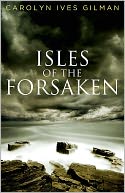 Isles of the Forsaken by Carolyn Ives Gilman was one of those books that I picked to review because I thought I was going to like it. Then I nearly didn’t. Then I read it all in a big clump, because I had to find out what happened. And about two-thirds of the way through, I realized that the author couldn’t possibly loop all the holes in the pages remaining. And she didn’t. Dammit, there’s a sequel.
Isles of the Forsaken by Carolyn Ives Gilman was one of those books that I picked to review because I thought I was going to like it. Then I nearly didn’t. Then I read it all in a big clump, because I had to find out what happened. And about two-thirds of the way through, I realized that the author couldn’t possibly loop all the holes in the pages remaining. And she didn’t. Dammit, there’s a sequel.
The story starts out in very familiar territory. A young man, Nathaway Talley, is the youngest son of the most prominent family in the kingdom. The Talleys run everything, and they excel at everything. At least, all of them do except Nathaway. Nat can’t find any profession to put his heart into, until he joins the expedition to the Forsaken Islands as a junior Justice. He discovers that enlightening the “heathens” about the impartial beauties of law and civilization are the calling that he has been waiting for.
Harg Ismol is a captain in the Native Navy. But that is not quite enough of a description. Harg is the one, the only Adaina captain in the Native Navy. His people are the “heathens” that Nat’s expedition is coming to civilize. Harg’s people in the South Chain islands have remained isolated, and kept to their old ways. They still believe in the balance of nature and the spirits of their islands. Harg’s people are not just subjugated by Nat’s empire, which has until now been far away fighting another war, but they have been under the much closer thumb of the people of the North Chain Islands, under the rule of the Tiarch, who have been collaborating with Nat’s people, the Innings.
At the opening of Isles, Harg Ismol resigns his Naval commission and returns to his tiny home island of Yora. He thinks he is returning to the paradise he remembers from his youth. But nothing is as he remembers it, because he is not the same.
On Yora, the final subject of the story resides. Spaeth Dobrin is a ritual healer She is one of the people that Nat is planning to save. Ritual healers don’t cure with herbs, or even with spells, although that is what the Innings believe. Ritual healers, Lashnura, are a different race altogether. They are compelled by their nature to heal. They cure by binding themselves to the people they heal by giving up their blood, and their life essence, as part of the healing. But Spaeth does not want to be bound. She rebels against her nature.
Everyone in this story is in rebellion. Nat’s is a quiet rebellion against his family’s expectations. Harg was a youthful rebel against the Adaina spirit of compromise, so he joined the Navy. Returning, he becomes the voice of the Adaina rebellion against Inning imperialism. Spaeth rebels against her nature, her own body’s need to become a healer.
Even the secondary characters are in revolt. The last spiritual leader of the Islands hides on a tiny outpost and refuses to name a successor. The Tiarch, the Satrap-like governor of the Islands, finally rebels against the Inning empire. Even the Admiral of the Inning Fleet revolts against the rule of Law and Order he is sent to bring to the Islands.
The Inning imperials’ civilization is itself a rebellion against the very nature and naturalism of the Forsaken Islands. And the living spirits of the Islands rise up in rebellion to overthrow that civilization, taking the confused son of the empire as one of their representatives.
Does the plot of the story confuse? Yes, it does at points. A little backstory on how the Talleys and the Inning Empire got to where they are, and who they fought in that previous war, would have helped this reader. But once all the players in this drama are gathered together it is impossible to turn the pages fast enough to find out what happens next.








